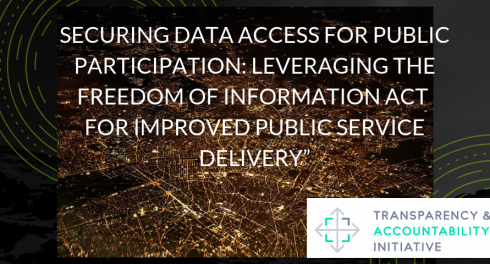Are you investing in governance data? Find our top five lessons learned from reviewing evidence on the outcomes of governance data initiatives to date.

In 2017, TAI partnered with the Open Data Charter to develop a “data for accountability” framework for understanding investments in open data for transparency and accountability (“governance data”) and how these investments can lead to impact. Going beyond standard conceptualizations of data “supply” and “demand”, the framework outlines five types of activity needed to result in impact, from governance data production, sharing and processing (needed to ensure data availability), data processing and action on this basis (needed for data use) and action leading to some sort of response (needed for enhancing accountability). This framework allows organizations investing in governance data to map their activities along the chain and uncover potential gaps in support needed to get to impact. This parallels other efforts to map the steps from data production to impact, such as Open Data Watch’s “data value chain” and AidData’s “four C’s” framework.

Of course, the challenge for funders of governance data initiatives is not only to determine where to focus their efforts but to ensure funding for governance data is impactful, i.e., that it effectively helps to address or overcome barriers to data disclosure, use, and accountability.
In an effort to support TAI members to improve the targeting and effectiveness of their funding for governance data, we began by reviewing evidence on the outcomes of governance data initiatives to date.
Here are our top five lessons learned:
1. Support governance data activities that are problem-driven, not data-driven
Within the open data community, there is a tendency to assume that more open data is intrinsically good, and the use of that data will lead to greater transparency and accountability over time. Governance data projects that aim to stimulate open data use are thus often designed around a pre-defined dataset (i.e. budget data or extractives data), and then work to identify and promote meaningful applications of the data to address accountability problems. Borrowing lessons from problem-driven iterative adaptation (PDIA) approaches, interventions to encourage data use should be designed around the specific governance problems that accountability actors are working to address, before considering whether and how data (governance and otherwise) might be needed in order to address them. This would likely help to ensure data uptake contributes more meaningfully to changes in decision-making, advocacy and/or citizen engagement.
2. Identify and take steps to understand and engage governance data users throughout implementation
Potential users of governance data encompass a range of groups with various capacities, preferences, governance objectives and information needs. Governance data initiatives should have or gain a solid understanding of the specific users and use cases they intend to target from the start, engage them in project design and implementation, and encourage feedback loops between data producers and users. This includes understanding and targeting barriers to data use (such as access to technology) among certain disadvantaged groups, including women (particularly given the historically gender-blind approaches of transparency and accountability initiatives). Thus far, user-centered approaches to governance data have been hindered by the lack of available user experience (UX) design expertise in many geographies; therefore, support should also help to strengthen UX capabilities and actors to facilitate this approach.
3. Prioritize efforts to produce or leverage actionable governance data (relevant/aligned with demand, timely, credible, feasible and accessible)
While the demand side of governance data is receiving more and more attention these days (as it should), persistent challenges to the supply of governance data remain critical to address in order to build the foundations for data use on a sustainable basis. These challenges not only include data quality and credibility, but also the capacity, incentives, infrastructure, resources, and legal and regulatory frameworks needed to produce and disclose the data on a regular basis, as well as gaps between data supply and demand – or in other words, ensuring the data are relevant and feasible to produce to address the problem at hand.
4. Align country support for governance data with governance reforms and moments
Governments are more likely to respond to data-driven analysis, advocacy and engagement in support of existing commitments or reforms that have traction, political buy-in and dedicated resources (for example, OGP National Action Plans or sector-specific reform plans). Integrating governance data programs in legal/policy frameworks for public information management and sharing, such as the right to the information laws and open data policies, could also help institutionalize the changes introduced by the program. Leveraging “critical junctures” or moments for reform, such as in the lead-up to, during or immediately following elections or at the outset of a political or economic crisis, can also further incentivize responsiveness to demands for reform.
5. Measure governance data uptake and impact
Numerous examples and case studies highlight the significance of open data and data use for transparency and accountability, yet stories and evidence of impact are not yet being captured systematically. This has contributed to gaps in our knowledge of how data influences change processes. Governance data funders can encourage shifts in how we measure outcomes and impact related to data by supporting organizations to build data more explicitly into theories of change, results, frameworks, and monitoring, evaluation, and learning plans. This not only helps improve the effectiveness of their own resources but would contribute to learning for the field.
Within the open data community, these takeaways are not groundbreaking nor are they specific only to governance data. However, they bear repeating, particularly for transparency and accountability funders with less knowledge or familiarity with improving the impact of open data within governance interventions. Next up, we share guiding questions developed for funders and grantees to try and put these considerations into action when reviewing funding proposals, strengthening project design and monitoring implementation.
This blog was written by Liz Dodds.

